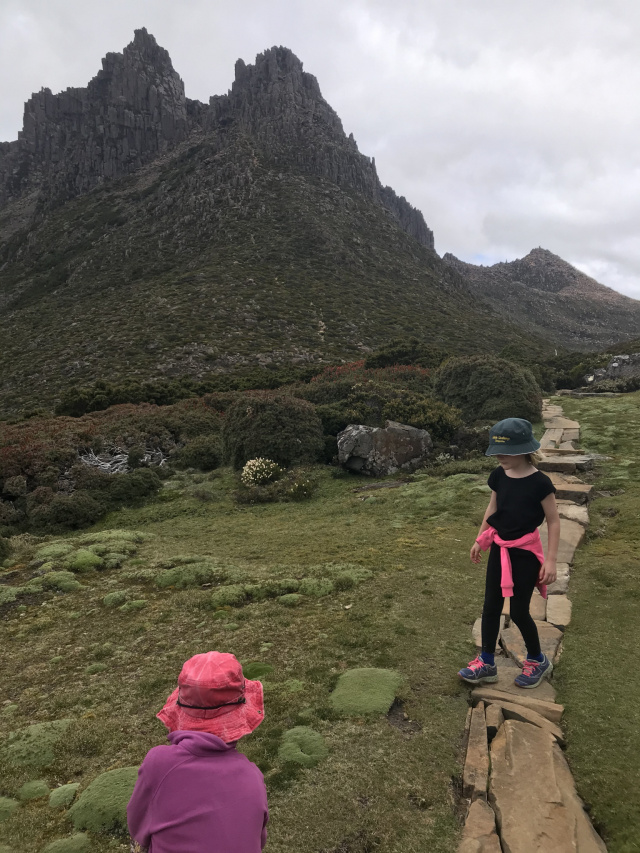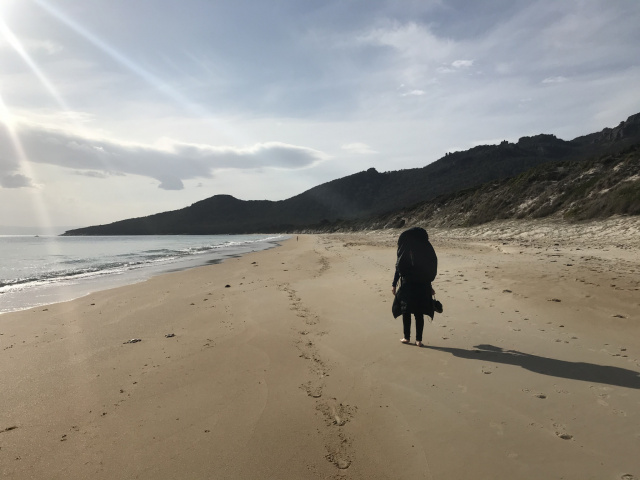Preparing for a Multi-Day Walk in Tasmania
An overnight bushwalk is a fantastic chance to immerse yourself into the wonders of the natural world, to properly wind down and ‘switch off’ from the stresses and strains of modern life, and to reconnect with what is important.
For any walker who takes on an overnight walk in Tasmania, irrespective of the location and remoteness, it is important to be properly prepared for natural hazards and volatile or easily changeable weather. Even in the middle of summer, walkers can and often are surprised by a sudden turn in the weather that brings wind, rain, bitter cold or even snow. This is particularly the case in Tasmania’s Alpine regions.
As a rule of thumb it is important to stick to and progressively extend your skills in overnight bushwalking compatible with your experience. If you’ve never done an overnight walk before, for example – then it is a better idea to stick with a shorter, easier and well-marked overnight walk as your starting point.

“When you go out there, you don’t get away from it all. You get back to it all. You come home to what’s important. You come home to yourself.” – Peter Dombrovskis
For a multi-day walk in Tasmania it is recommended walkers take:
- Strong, high quality water and windproof jacket and over-pants
- Waterproof gloves and Woollen Gloves
- Beanie
- Thick Jumper and additional warm clothing *NB: Keep your warm & cold weather gear in a separate waterproof bag within your pack
- Sun hat
- Sunscreen
- Light and quick-dry walking clothes (avoid denim / heavy cotton)
- Thick socks
- Sturdy worn-in walking boots and gaiters
- Tent (four seasons) and groundsheet
- Sleeping Bag (high quality – rated to -10 degrees Celsius for Alpine areas) and sleeping mat
- Dry spare clothing in waterproof bag (including beanie, spare socks, spare gloves, thermals)
- Toilet gear (toilet paper and trowel, toothbrush, personal toiletries)
- Fuel stove, pots and utensils
- Ample food (including extra food in case you take longer than anticipated or get stranded by weather or injury)
- Sturdy Backpack (a waterproof pack liner and pack cover is also recommended)
- Emergency bivvy or space blanket
- Water/windproof matches/lighter
- First Aid Kit, including extra medication supplies, and where necessary, a MedicAlert bracelet/necklace
- PLB (Personal Locator Beacon) / EPIRB
- Relevant 1:25,000 or 1:50,000 maps – in waterproof cover
- Mobile phone, but switched to flight mode and setup for offline navigation or emergency use, with spare mobile phone battery(s) (and/or take a GPS)
- Water bottle(s) and/or bladder with capacity of 2-3 litres
- Head-torch and spare batteries
- Rubbish bag for your waste (must be taken out with you)
- Whistle
- Pocket Knife
- Compass
- Small sewing / mending kit
- Rope in case of walks where a rope is needed as a safety line
- A favourite book, cards and some writing paper can also be useful

“Away, away, from men and towns, To the wild wood and the downs, To the silent wilderness, Where the soul need not repress its music.” – Percy Bysshe Shelley
Itinerary and Group Size
Before you go, always leave details of your proposed walk itinerary (including when you plan to return) with an emergency contact, so that your emergency contact can call police on 000 if you don’t return on time. A minimum group size of four is recommended, so that if someone is injured, one person can stay with them whilst the others return to get help. Leave your details and trip plans in the log-book at the start of the walk too.
Check the Weather
Remember to plan ahead and check the forecast before you leave – in certain weather it will be safer to postpone your trip, so be prepared to be flexible with your itinerary. The Bureau of Meteorology has forecasts and alerts for Tasmania here
Check for Bushfire Alerts or planned burns
Check the Tasmanian Fire Service and Parks & Wildlife Service planned burns pages for any bushfire or planned burns alerts.
Get a Parks Pass, Check for Parks Alerts and some walks require booking
If walking within a National Park, you need to ensure you have a Parks Pass which you can purchase here, and also check for any Parks & Wildlife Service Alerts beforehand – from time-to-time tracks will be closed for upgrades or other reasons and so it is important to check beforehand.
Prior booking is required for some of Tasmania’s most popular walks including those on the Overland Track, Frenchman’s Cap, the Three Capes Track, Farmhouse Creek and the Walls of Jerusalem. So make sure you book beforehand through the Parks & Wildlife Service, here
Further Reading
The latest edition of Safety in the Bush, published by the Hobart Walking Club, is a great resource (It can be purchased from the Tasmanian Map Centre or Hobart Walking Club, as is the Parks & Wildlife Service’s ‘Before You Walk – Essential Bushwalking Guide’ or ‘Safe walking guidelines’


Phill Pullinger
An overnight bushwalk is a fantastic chance to immerse yourself into the wonders of the natural world, to properly wind down and ‘switch off’ from the stresses and strains of modern life, and to reconnect with what is important.
For any walker who takes on an overnight walk in Tasmania, irrespective of the location and remoteness, it is important to be properly prepared for natural hazards and volatile or easily changeable weather. Even in the middle of summer, walkers can and often are surprised by a sudden turn in the weather that brings wind, rain, bitter cold or even snow. This is particularly the case in Tasmania’s Alpine regions.
As a rule of thumb it is important to stick to and progressively extend your skills in overnight bushwalking compatible with your experience. If you’ve never done an overnight walk before, for example – then it is a better idea to stick with a shorter, easier and well-marked overnight walk as your starting point.

“When you go out there, you don’t get away from it all. You get back to it all. You come home to what’s important. You come home to yourself.” – Peter Dombrovskis
For a multi-day walk in Tasmania it is recommended walkers take:
- Strong, high quality water and windproof jacket and over-pants
- Waterproof gloves and Woollen Gloves
- Beanie
- Thick Jumper and additional warm clothing *NB: Keep your warm & cold weather gear in a separate waterproof bag within your pack
- Sun hat
- Sunscreen
- Light and quick-dry walking clothes (avoid denim / heavy cotton)
- Thick socks
- Sturdy worn-in walking boots and gaiters
- Tent (four seasons) and groundsheet
- Sleeping Bag (high quality – rated to -10 degrees Celsius for Alpine areas) and sleeping mat
- Dry spare clothing in waterproof bag (including beanie, spare socks, spare gloves, thermals)
- Toilet gear (toilet paper and trowel, toothbrush, personal toiletries)
- Fuel stove, pots and utensils
- Ample food (including extra food in case you take longer than anticipated or get stranded by weather or injury)
- Sturdy Backpack (a waterproof pack liner and pack cover is also recommended)
- Emergency bivvy or space blanket
- Water/windproof matches/lighter
- First Aid Kit, including extra medication supplies, and where necessary, a MedicAlert bracelet/necklace
- PLB (Personal Locator Beacon) / EPIRB
- Relevant 1:25,000 or 1:50,000 maps – in waterproof cover
- Mobile phone, but switched to flight mode and setup for offline navigation or emergency use, with spare mobile phone battery(s) (and/or take a GPS)
- Water bottle(s) and/or bladder with capacity of 2-3 litres
- Head-torch and spare batteries
- Rubbish bag for your waste (must be taken out with you)
- Whistle
- Pocket Knife
- Compass
- Small sewing / mending kit
- Rope in case of walks where a rope is needed as a safety line
- A favourite book, cards and some writing paper can also be useful

“Away, away, from men and towns, To the wild wood and the downs, To the silent wilderness, Where the soul need not repress its music.” – Percy Bysshe Shelley
Itinerary and Group Size
Before you go, always leave details of your proposed walk itinerary (including when you plan to return) with an emergency contact, so that your emergency contact can call police on 000 if you don’t return on time. A minimum group size of four is recommended, so that if someone is injured, one person can stay with them whilst the others return to get help. Leave your details and trip plans in the log-book at the start of the walk too.
Check the Weather
Remember to plan ahead and check the forecast before you leave – in certain weather it will be safer to postpone your trip, so be prepared to be flexible with your itinerary. The Bureau of Meteorology has forecasts and alerts for Tasmania here
Check for Bushfire Alerts or planned burns
Check the Tasmanian Fire Service and Parks & Wildlife Service planned burns pages for any bushfire or planned burns alerts.
Get a Parks Pass, Check for Parks Alerts and some walks require booking
If walking within a National Park, you need to ensure you have a Parks Pass which you can purchase here, and also check for any Parks & Wildlife Service Alerts beforehand – from time-to-time tracks will be closed for upgrades or other reasons and so it is important to check beforehand.
Prior booking is required for some of Tasmania’s most popular walks including those on the Overland Track, Frenchman’s Cap, the Three Capes Track, Farmhouse Creek and the Walls of Jerusalem. So make sure you book beforehand through the Parks & Wildlife Service, here
Further Reading
The latest edition of Safety in the Bush, published by the Hobart Walking Club, is a great resource (It can be purchased from the Tasmanian Map Centre or Hobart Walking Club, as is the Parks & Wildlife Service’s ‘Before You Walk – Essential Bushwalking Guide’ or ‘Safe walking guidelines’

Love what you're reading? Support Kuno donate to support them now
Donate hereYou might like...

Freestyle Polo

Genetic diversity and saving the forty spotted Pardalote

Nature's Protection: Heart connection is the key

Re-wilding Europe – Western Iberia
Newsletter
Sign up to keep in touch with articles, updates, events or news from Kuno, your platform for nature
